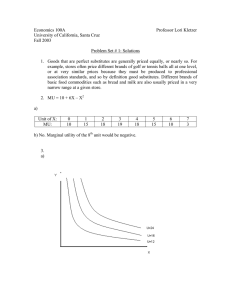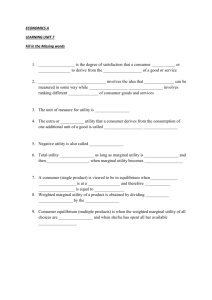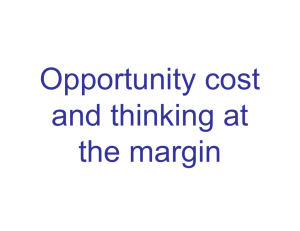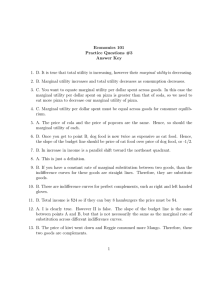11282011_Monopsonistic
advertisement
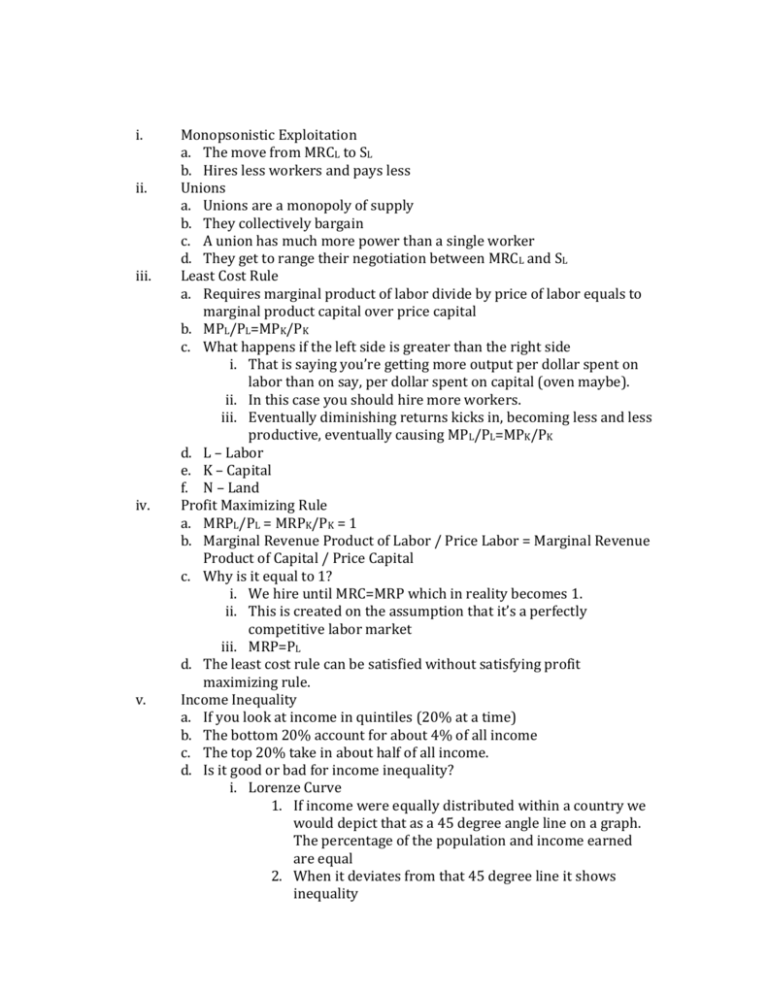
i. ii. iii. iv. v. Monopsonistic Exploitation a. The move from MRCL to SL b. Hires less workers and pays less Unions a. Unions are a monopoly of supply b. They collectively bargain c. A union has much more power than a single worker d. They get to range their negotiation between MRCL and SL Least Cost Rule a. Requires marginal product of labor divide by price of labor equals to marginal product capital over price capital b. MPL/PL=MPK/PK c. What happens if the left side is greater than the right side i. That is saying you’re getting more output per dollar spent on labor than on say, per dollar spent on capital (oven maybe). ii. In this case you should hire more workers. iii. Eventually diminishing returns kicks in, becoming less and less productive, eventually causing MPL/PL=MPK/PK d. L – Labor e. K – Capital f. N – Land Profit Maximizing Rule a. MRPL/PL = MRPK/PK = 1 b. Marginal Revenue Product of Labor / Price Labor = Marginal Revenue Product of Capital / Price Capital c. Why is it equal to 1? i. We hire until MRC=MRP which in reality becomes 1. ii. This is created on the assumption that it’s a perfectly competitive labor market iii. MRP=PL d. The least cost rule can be satisfied without satisfying profit maximizing rule. Income Inequality a. If you look at income in quintiles (20% at a time) b. The bottom 20% account for about 4% of all income c. The top 20% take in about half of all income. d. Is it good or bad for income inequality? i. Lorenze Curve 1. If income were equally distributed within a country we would depict that as a 45 degree angle line on a graph. The percentage of the population and income earned are equal 2. When it deviates from that 45 degree line it shows inequality 3. The further the curve from the initial 45 degree line the more unequal it is 4. Pros and cons of income redistribution a. The argument for an equal distribution rests on utility maximization b. Each additional dollar gives them less and less utility. c. If taking away $2500 from B and giving it to A there’s still a net gain of utility d. People argue it maximizes utility e. Example: i. If Bill Gates drops a $20 bill, his loss of utility is near nothing. If that $20 bill is given to someone living on a park bench his gain is very much f. Opponents i. Incentives to produce are harmed ii. Using the same example about person A & B iii. “Hey if I only work for $2,500 and get a free $2,500 to get me to $5,000 – why work to get $5,000? There’s no reason to” iv. “If I work for $7,500 and I only get to keep $5,000 why must I work beyond the first $5,000” v. In the above example person B will stop at $5,000 and then person A will continue producing $2,500 – thus lowering the total output from $10,000 initially to now $7,500. 5. Market Failure – Whenever the market fails to provide an efficient quantity. Usually that means not enough, sometimes that means too much. a. Provision of public goods b. Goods that generate externalities c. Information failure or imperfect information d. Those all result in an inefficient outcome in these cases 6. What is a public good? a. Non-rival and non-exclusive b. Non-rival i. Many people can enjoy the good at the same time, one persons use doesn’t diminish another’s. c. Non-exclusive i. You can’t prevent someone from using the good, or to do so would be prohibitly costly. ii. “Free Rider Problem” 1. If you can’t exclude me what incentive do I have to pay for it? d. An example would be national defense; one persons use doesn’t diminish another. You don’t feel less safe today than yesterday even though the population has grown a few thousand. You can’t exclude anybody. Whether they pay their taxes they still are safe. e. Another example would be police and fire services, they can be rival ie 10 fires break out at once but there is still not the exclusivity. When you dial 911 they still come regardless if you pay the taxes, etc. f. Lighthouses, if one ship sees the light and another ship comes up the lighthouse doesn’t get dimmer.






